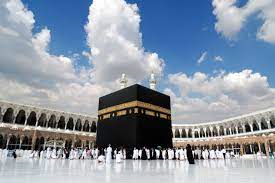Umrah is an Islamic pilgrimage to Mecca. It is not compulsory but is highly recommended for Muslims. It can be performed at any time of the year and is often combined with the Hajj pilgrimage. Umrah is a lesser pilgrimage than the Hajj and can be performed in a shorter period.
Many Muslims choose to perform umrah as a way to deepen their spirituality and connection to Islam. The rituals involved in umrah are similar to those of hajj but on a smaller scale. Umrah has great religious significance and is a way of showing devotion to Allah. It is also an opportunity to perform good deeds and earn rewards from Allah.
Table of Contents
How to perform Umrah:
Umrah is performed by following the four basic pillars. These four basic pillars of Umrah according to Hanafi Fiqh are as follows:
1- Ihram
2- Tawaf
3- Sa’ee
4- Taqsir or cutting of the hair
1- Ihram :
Ihram is a state of mind and body that is required when performing the Hajj or Umrah pilgrimages. It can be thought of as a sacred state, in which pilgrims are purified and cleansed of all sin. Ihram clothing is simple and white, which represents the equality of all pilgrims before Allah. Pilgrims wear Ihram as a symbol of their intention to perform the pilgrimage and to stand before God in a state of purity.
The state of Ihram begins when pilgrims enter the Miqat. The miqat is the point at which a pilgrim enters into the state of ihram, and is typically located at the boundaries of the holy city of Mecca. It is a designated area where pilgrims must put on their Ihram clothing. This clothing consists of two white sheets for men or a simple white dress for women. Once pilgrims have donned their Ihram clothing, they must make an intention, or niyah, to perform the Hajj or Umrah. After making the niyah, pilgrims are not allowed to shave, cut their hair, or wear perfume. These restrictions are meant to help pilgrims focus on their spiritual journey and not on worldly matters.
The state of Ihram ends after the completion of the Hajj or Umrah. At this point, pilgrims are free to return to their normal lives and dress.
2- Tawaf :
Tawaf is one of the most important aspects of Umrah and is a fundamental part of the pilgrimage. It involves circumambulating the Kaaba seven times in a counter-clockwise direction. Tawaf is a physical and spiritual act of worship that helps pilgrims to focus their attention on Allah and remember the purpose of their pilgrimage. It is recommended that pilgrims perform Tawaf as soon as they arrive in Mecca, after performing the necessary rituals of Umrah. However, if they are unable to do so, they can perform Tawaf at any time during their stay in Mecca. Pilgrims must be in a state of ritual purity (ihram) in order to perform Tawaf. They should also make sure to perform the ritual with the intention of seeking Allah’s pleasure.
- How to perform Tawaf in Umrah :
- Make the intention to perform Umrah. You can do this by saying “I intend to perform Umrah. I will make Tawaf of the Kaaba seven times, and I will make Sa’ee between Safa and Marwah seven times.”
- Then perform ablution (Wudu) if you are not already in a state of purity.
- Next, Put on your Ihram clothing. Men should wear two pieces of white, unsewn cloth. One is wrapped around the waist and the other is draped over the shoulder. In addition, women should wear loose, modest clothing.
- Recite the Talbiyah. This is the declaration of intention to perform Umrah. It is recited three times: “Labbayka Allahumma Umrah.”
- Start your Tawaf from the Black Stone. If you cannot reach the Black Stone, point to it with your hand. Then, kiss the Black Stone or touch it with your right hand and recite: “Bismillahi wa ‘ala millati Rasulillah. Allahumma salli ‘ala Muhammad wa ‘ala Ali Muhammad. Kullu amrin yusolli ‘ala Rasulillah.” The seven rounds of Tawaf represent the seven days of Creation. Each circuit begins at the Black Stone (al-Hajar al-Aswad) and ends at the Station of Ibrahim (Maqam Ibrahim). Pilgrims are also encouraged to pray and recite the Quran at these two holy sites.
- After completing Tawaf, pilgrims perform two units of prayer (rak’ahs) at the Maqam Ibrahim. They then drink from the Zamzam Well and perform seven more circuits of Tawaf, known as Tawaf al-Ifada. This tawaf follows by the sacrifice of an animal (if possible) and the shaving or clipping of the hair.
3- Sa’i :
Sai is an Arabic word meaning “to move quickly in small steps”. Sai is one of the rituals of Umrah. It is a ceremonial walk between the hills of Safa and Marwah seven times undertaken by Muslims during Umrah and Hajj pilgrimages. In this, seven circuits include, starting and ending at the Black Stone. Each circuit begins at Safa and ends at Marwa. It’s highly recommended Sunnah of the Prophet Muhammad ﷺ. Sai is a means of seeking Allah’s mercy, forgiveness, and blessings.
It considers one of the most important aspects of the pilgrimage and is often seen as a symbol of the spiritual journey of the pilgrims. Sai is a symbol of the difficulties that Prophet Ibrahim and his family went through during their search for water. Furthermore, this performs for commemorating the journey of Prophet Muhammad and his wife, Hazrat Khadijah, during which they had to walk between these two hills multiple times in search of water.
The sai is a way of paying homage to the House of Allah. It is also a way of demonstrating the pilgrims’ love and devotion to Allah. The sai is a very special and significant ritual for Muslims, and often perform as a once in a lifetime opportunity to show their dedication to Allah.
- How to perform sa’i in umrah :
- First, make your intention to perform sa’i.
- Then, pray two rakats of Sunnah prayer at Maqam Ibrahim.
- After the Sunnah prayer, face the Black Stone and perform tawaf around the Kaaba seven times.
- After completing the tawaf, head towards Safa and Marwah.
- Start your sa’i by running seven times between Safa and Marwah.
- Lastly, after completing the sa’i, offer two rak’ahs of prayer at Maqam Ibrahim.
4- Taqsir or cutting of the hair :
Taqsir is the cutting of the hair in umrah and is a symbol of humility and submission. It usually performs at the end of the umrah, after the pilgrims have completed all the required rites. It is a Sunnah for the men to shave their heads or cut their hair short during Umrah. In addition, women should also cut their hair short or shave their heads.
- How to perform Taqsir in Umrah :
- The Taqsir or cutting of the hair is a Sunnah of Umrah and is done after performing the Tawaf.
- It recommends doing the Taqsir on the 10th of Dhul-Hijjah or the days of Arafat.
- The person performing the Umrah should go to the Haram and make Tawaf first.
- After the Tawaf, the person should offer 2 Rak’ahs of Nafl behind Maqam Ibrahim.
- After the Nafl, the person should proceed to do the Taqsir.
- The person should find a place in the Haram to do the Taqsir.
- The person should face the Ka’bah and make the intention of doing the Taqsir.
- The person should then take a handful of hair and recite the Takbir.
- After the Takbir, the person should cut the hair with a sharp object.
- The person should then make another Takbir and cut the hair again.
- Then the person should repeat this process until all the hair cuts.
- The person should then offer 2 Rak’ahs of thanksgiving behind Maqam Ibrahim.
Tawaf al-Ifadah :
After Taqsir, pilgrims should perform Tawaf al-Ifadah which is similar to the Tawaf al-Quduus performed during hajj. It is the final circumambulation.
The first thing after Taqsir is to make sure that all of the proper clothing puts on. This includes the ihram, which is a white garment that men wear, and also the niqab, which is a veil that women wear.
After that, the next thing is to perform the ablutions, which are a series of cleansing rituals. Once that is done, further, the next thing to do is to say the Talbiyah, which is a declaration of intention to perform the pilgrimage.
After that, the next thing to do is to head to the Kaaba, which is the holiest site in Islam. After this, finally, pilgrims remove the Irham and pilgrims can return to normal life.
Conclusion
If you are planning on performing Umrah, there are a few things that you should keep in mind. The article discusses various aspects of performing Umrah, including the intention, and the correct methods of performing the rites. It is a clear and concise guide that should be useful for anyone planning to undertake this pilgrimage. Additionally, you should familiarize yourself with the customs and rituals associated with Umrah so that you can perform them correctly. There are a lot of businesses running in today’s era that offer amazing umrah services. Finally, you should be prepared to financially support yourself during your stay in Saudi Arabia.











